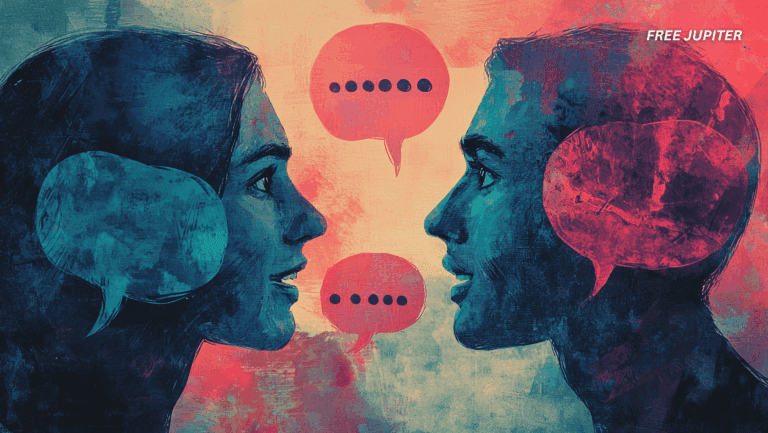Friendly Note: FreeJupiter.com shares general info for curious minds 🌟 Please fact-check all claims—and always check health matters with a professional 💙
Take a quick glance at the top of any modern browser, and chances are you’ll see it: an endless row of little rectangles stacked so tightly that only a few cryptic icons remain visible. To outsiders, it looks like clutter, a chaotic mess begging to be organized. But to the person behind the screen, those tabs aren’t just random digital scraps—they’re a map of a restless, curious, and adaptive mind.
Psychologists and behavioral researchers have noted something fascinating about this habit. People who constantly leave dozens of tabs open tend to share specific thought patterns and traits. What looks like digital chaos is often an external reflection of how the brain processes information, manages curiosity, and navigates the overwhelming complexity of modern life.
So, if there are twenty, thirty, or maybe even fifty tabs staring back at you right now, here’s what that behavior may reveal about the way your mind works.
1. Fueled by Intellectual Curiosity (and FOMO)
Closing a tab can feel oddly risky, like throwing away an opportunity. This ties into something researchers call maximizing behavior—the tendency to keep options open rather than making final choices.
Every open tab is a possibility: an article you might read later, a recipe worth testing, or a video tutorial that promises to teach a new skill. Unlike a bookmark—which feels like filing something away into a dusty cabinet—an open tab stays alive, visible, and ready for action.
This trait often connects to openness to experience, one of psychology’s core personality dimensions. People high in openness are naturally drawn to exploration, novelty, and abstract thinking. In other words, that never-ending browser window isn’t just clutter—it’s a digital library of “what-ifs,” each tab representing curiosity that refuses to be silenced.
Example: Imagine walking into a bookstore and feeling the urge to skim every section—from philosophy to gardening to world history—before deciding what to buy. That same impulse lives in the browser, where the “just in case” tabs pile up like half-opened books left waiting on a table.
Read more: 12 Traits That Prove You’re More Capable Than Most People, According To Psychology
2. A Brain That Craves Constant Stimulation
Some people thrive with singular focus: one task, one screen, one goal. But for chronic tab-keepers, this kind of tunnel vision can feel stifling. Multiple tabs serve as intellectual appetizers, feeding a mind that craves variety.
Studies on media multitasking suggest that certain brains actually operate better when toggling between streams of input. Jumping from a dense academic article to a lighthearted news piece isn’t necessarily distraction—it can be mental refreshment. Like channel-surfing on television, it gives the brain micro-breaks that keep energy flowing.
Instead of forcing through boredom, the mind simply shifts gears, returning later with renewed focus. In this sense, tabs become tools for productivity rather than obstacles.
Example: Someone studying for an exam might keep ten different tabs open—lecture slides, practice quizzes, explanatory YouTube videos, and maybe even a meme page for comic relief. Each switch isn’t avoidance but a way of keeping the mind awake, energized, and engaged.
3. Optimistic Planning Meets Terrible Time Estimates
Every open tab represents faith in the future self. The assumption goes: “I’ll definitely get around to reading that 7,000-word deep dive on climate policy” or “next week I’ll finally try that sourdough recipe.”
Psychologists call this the planning fallacy: the tendency to underestimate how long tasks will take and to overestimate personal capacity. Optimism fuels the hoard, convincing the mind that all these tabs will eventually be conquered.
While this may lead to digital clutter, it’s also a sign of self-belief. Each tab is like a little promise to future potential. Even if most of them never get finished, the act of keeping them open reflects confidence in personal growth.
Example: Think of it as leaving workout equipment visible in the living room. It might not get used every day, but the presence itself is a reminder of the goal—a vote of confidence in the person you want to become.
4. Stress Processing Through Information Hoarding
Notice how the number of tabs often spikes during stressful times? A big work deadline suddenly requires twenty research windows. A medical worry quickly leads to a dozen health articles.
This is a psychological coping mechanism. Collecting information can soothe anxiety, giving the sense of being more prepared or in control. Each tab represents a lifeline, a potential solution, or a path toward reassurance. Closing them can feel like letting go of safety nets.
Researchers link this to intolerance of uncertainty. When life feels unpredictable, the brain tries to reduce discomfort by surrounding itself with possible answers—even if many of them never get read.
Example: Someone feeling nervous about an upcoming presentation might open a flood of tabs: guides on public speaking, videos of TED Talks, articles on calming nerves, even forums where others share their fears. The act of keeping them open becomes a way to carry reassurance, like a digital “comfort blanket.”
5. A Mind Wired for Connections
What looks random on the surface—recipes next to history articles next to podcasts on brain science—is often part of a bigger process. The mind behind those tabs is constantly making connections.
Psychologists describe this as divergent thinking: the ability to generate multiple solutions, ideas, and associations from seemingly unrelated input. Instead of moving in straight lines, the brain maps constellations.
When two unrelated tabs suddenly “click” into a new idea, that’s creativity at work. The mess is actually fertile ground for innovation.
Example: A tab about urban gardening might spark an idea when sitting next to an article on sustainability, eventually leading to a community project. The browser becomes a workshop of raw materials, waiting for connections to spark.
Read more: If You’ve Ever Done These 8 Things, You’re a Person of Rare Integrity In This World
6. A Complicated Relationship with Completion
There’s a well-known psychological effect called the Zeigarnik effect: the mind clings to unfinished tasks. This explains why an open tab can haunt the back of the brain like a ghost, resisting closure until it feels “resolved.”
For tab-hoarders, closure is difficult. There’s always more information to squeeze out, more value to extract, more reasons to hold on. This often leads to an odd mix of frustration and relief when a browser suddenly crashes. The decision to “let go” wasn’t personal—it was technological fate.
It’s less about laziness and more about perfectionism’s quirky cousin: the fear of ending something too soon.
Example: Think of a novel that remains half-read on the nightstand. Closing the book for good feels like admitting defeat. Open tabs work the same way—unfinished business begging for completion, even if it never comes.
7. An Adaptive Response to Information Overload
Human memory wasn’t designed for the digital age. With more information coming at us daily than our ancestors processed in a lifetime, the brain needs scaffolding. For many, browser tabs serve as external memory banks.
Each tab is a frozen thought, a bookmark for ongoing conversations, or a placeholder for complex ideas too bulky to juggle in working memory alone. This isn’t disorganization—it’s adaptation.
Instead of rejecting complexity, the brain extends itself into the digital space, using the browser as a second brain. In many ways, messy tab behavior is simply the modern human mind stretching to fit the demands of the information age.
Example: Think of tabs as sticky notes plastered across a wall—messy, yes, but essential to keep track of dozens of moving parts. They’re less about chaos and more about survival in an overwhelming environment.
8. Comfortable in Controlled Chaos
For many, tab clutter isn’t limited to browsers. It shows up as messy desks, multiple unfinished projects, and a tendency to juggle different roles at once. But hidden inside this apparent disorder is a powerful skill: the ability to hold multiple mental contexts simultaneously.
Where some people require strict order and focus, others thrive in controlled chaos. They can switch between spreadsheets, creative drafts, and news feeds without losing the thread in any of them. This context-switching ability—often criticized as inefficient—may actually be a superpower in environments that demand flexibility and rapid adaptation.
In short, the tabs aren’t just clutter. They’re evidence of a brain that has trained itself to handle multiple realities at once.
Example: A designer might keep design tools, music playlists, research articles, and feedback forms all open at the same time. Instead of overwhelming them, the mix provides the stimulation needed to spark fresh solutions.
Read more: If You Don’t Reply to Texts Immediately, You Probably Have These 10 Traits
Final Thoughts
The next time a crowded browser window earns judgmental stares, remember this: tab-hoarding isn’t simply disorganization. It’s often the mark of a curious, creative, and adaptive mind trying to navigate an information-heavy world.
Yes, some tabs will sit untouched for months. Yes, half will never be read. But that’s not the point. Those tabs aren’t failures—they’re footprints of curiosity, proof that the mind is still hungry for exploration.
In a society that constantly pressures people to streamline, tidy up, and “close all the boxes,” leaving tabs open might be its own form of quiet rebellion. It signals a refusal to shut down curiosity just because time is limited.
The mess at the top of the browser is more than clutter—it’s a map of wonder, possibility, and human resilience in the digital age.










